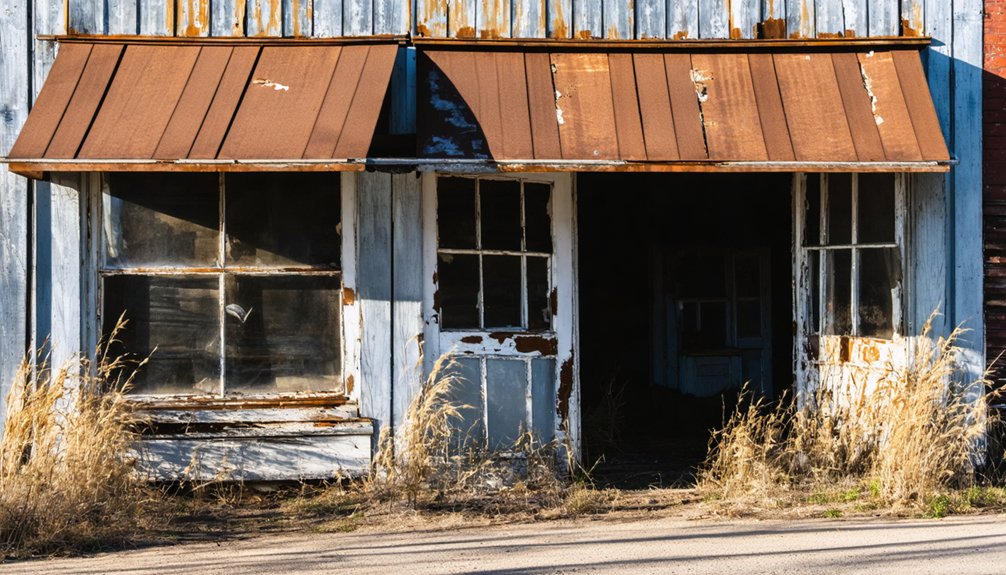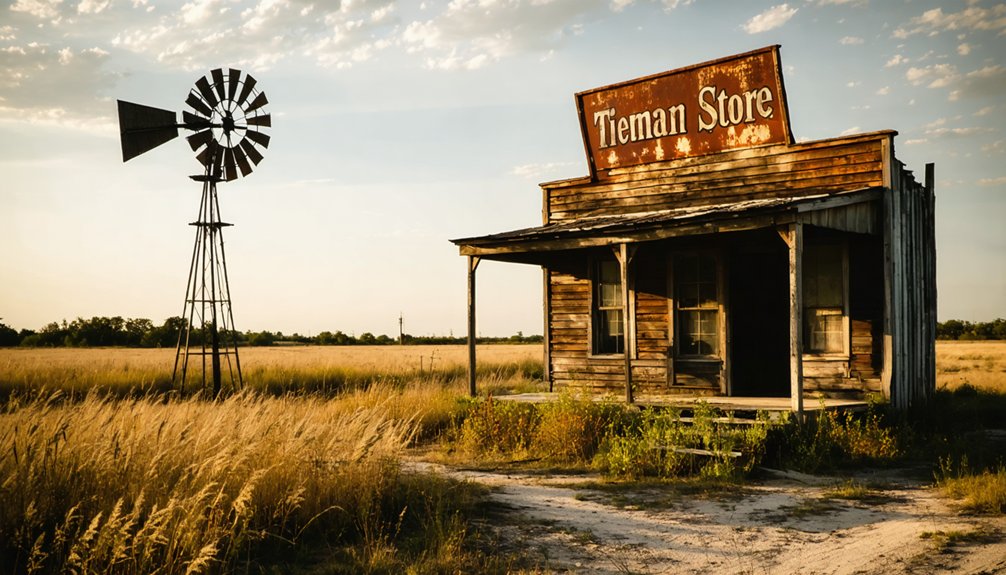You’ll discover Tiemann as a haunting Texas ghost town that once thrived on agriculture and community spirit in the late 1800s. The town’s decline began in the 1930s when agricultural markets shifted, and the fatal blow came in 1942 when railroad routes changed. Today, only crumbling remnants and scattered mining artifacts tell the tale of this abandoned settlement. Its story mirrors countless other Texas towns that couldn’t survive economic upheaval and changing transportation patterns.
Key Takeaways
- Tiemann, Texas declined in the 1930s due to agricultural market shifts and the devastating impact on cotton farming.
- The rerouting of the Texas & New Orleans Railway in 1942 cut off vital transportation links, leading to business closures.
- The town’s economic collapse stemmed from dependence on cotton farming and inability to diversify crops like neighboring regions.
- Only deteriorating architectural remnants and mining artifacts remain, requiring off-road vehicles to access the abandoned site.
- Nature has reclaimed most of the town, while local folklore and documented history preserve Tiemann’s cultural heritage.
The Rise of a Rural Community
While many Texas ghost towns emerged from the late 19th century’s westward expansion, Tiemann’s establishment followed the typical pattern of rural community development through private land acquisition and strategic positioning.
You’ll find that early settlers faced settlement challenges typical of frontier life, yet their community resilience shone through as they built the foundations of their new home. Like many frontier settlements, they relied on safe river crossings to establish their community and thrive.
Like many of their contemporaries, they established essential services – a general store, post office, and school – creating a hub of activity that drew more settlers to the area. Similar to Independence, Texas, which became a wealthy economic hub, the town developed into an important center for local commerce.
Building essential community services sparked a chain reaction, transforming isolated settlements into thriving frontier towns where pioneers could put down roots.
As ranchers and farmers claimed their stakes, they formed tight-knit social networks centered around these gathering places.
The community’s growth reflected the pioneering spirit, with businesses emerging to serve daily needs while churches and schools fostered the social bonds necessary for survival.
Life in Early Tiemann
Despite limited historical records, life in early Tiemann reflected the typical patterns of rural Texas communities in the late 19th century.
You’d have found families working together on farms, with children helping their parents tend to crops and livestock. The town’s cultural heritage was rich with influences from European settlers and Mexican neighbors, shaping everything from local cuisine to music.
Family dynamics centered around traditional roles, with women managing households while men worked the fields. Similar to Belle Plain College in 1881, education played a vital role in community development. Like the miners in Thurber, workers often received their wages through a once-a-month paycheck.
You would’ve experienced a close-knit community where neighbors helped neighbors, gathering for church services, harvest festivals, and holiday celebrations.
Daily life revolved around agriculture, with the Texas climate dictating planting and harvesting schedules.
Basic services included a general store and postal delivery, though modern amenities were scarce.
Economic Forces Behind the Decline
You’ll find that Tiemann’s decline stemmed from the devastating effects of agricultural market shifts in the 1930s, which severely impacted the town’s farming-dependent economy.
The rerouting of the railroad line away from Tiemann in 1942 dealt another significant blow, cutting off essential transportation links that had sustained local commerce. This followed a pattern seen across the region where two-thirds of residents departed, leaving communities to wither.
Local businesses, including the general store and cotton gin, shuttered their doors throughout the 1940s as both farmers and merchants sought opportunities elsewhere. Like many of the 511 ghost towns across Texas today, Tiemann exemplifies how economic challenges can lead to complete community abandonment.
Agricultural Market Changes
Throughout the mid-twentieth century, Tiemann’s economic foundation crumbled under mounting pressures in the agricultural market, particularly in cotton farming. You’d have witnessed the town’s struggle as rising costs of seeds, fertilizer, and labor squeezed local farmers’ profits. Like many of Texas’s ghost towns, Tiemann’s fate was sealed when its primary reason for existence vanished.
While nearby regions in Texas Hill Country embraced crop diversification and market adaptation through organic farming and vineyards, Tiemann’s cotton-dependent economy couldn’t keep pace. Today, the Texas Hill Country stands as the second-most-visited wine region in America, highlighting the successful agricultural transitions other communities made.
The shift to industrial-scale agriculture dealt another blow to your community’s smallholder farmers. As mechanization favored larger operations, you’d have seen your neighbors gradually abandon their fields.
The town’s inability to tap into emerging specialty markets, combined with soil depletion and limited access to capital, accelerated its decline. Local businesses shuttered as agricultural income dwindled, forcing residents to seek opportunities elsewhere.
Railroad Route Shifts
As rail companies consolidated their operations in the late 19th century, Tiemann’s fate became intertwined with the shifting priorities of the Texas & New Orleans Railway.
The Southern Pacific Railway owned T&NO operations as they primarily served southeast Texas.
By the late 1800s, outside interests gained control over numerous Texas railroad companies, reflecting a broader industry consolidation.
You can trace the town’s decline through railroad history, as companies abandoned less profitable secondary lines in favor of major corridors with higher traffic volumes.
The transportation evolution hit Tiemann particularly hard when rail companies faced growing competition from automobiles and trucks in the mid-20th century.
Like many small Texas towns, Tiemann couldn’t survive the economic impact of lost rail service.
The Interstate Commerce Commission’s regulatory changes in the 1960s-70s made it easier for railroads to discontinue unprofitable routes, effectively cutting off Tiemann’s essential connection to larger markets.
Without rail access, businesses closed and residents moved away, leaving behind another Texas ghost town.
Local Business Exodus
While rail service played an essential role in Tiemann’s decline, the town’s economic collapse stemmed from its dangerous dependence on a single industry.
You’d have seen business resilience crumble as agricultural downturns triggered a devastating chain reaction. When crop prices fell, local merchants watched their customer base evaporate, forcing them to shutter their shops one by one.
Without community investment in diverse enterprises, you would’ve witnessed young residents fleeing to cities for better opportunities.
This exodus accelerated the town’s deterioration – fewer customers meant even more business closures, which led to reduced tax revenue and declining public services.
The remaining enterprises faced mounting challenges: deteriorating infrastructure, vanishing support services, and a shrinking pool of workers, creating an irreversible spiral toward abandonment.
Lost to Time: The Town’s Abandonment

Looking through historical records, you’ll find Tiemann’s population dwindled rapidly as economic opportunities vanished and younger residents sought prospects elsewhere.
The town’s decline accelerated when businesses shuttered and essential services disappeared, leaving aging buildings as silent witnesses to the community’s exodus.
You can trace how economic forces common to Texas ghost towns – from shifting transportation routes to changing industrial landscapes – transformed Tiemann from a living community into an abandoned settlement.
Rapid Population Exodus
During the mid-20th century, Tiemann’s population experienced a dramatic exodus that sealed the town’s fate. The population dynamics shifted dramatically as younger residents sought opportunities in urban centers, leaving behind an aging community struggling to maintain basic services.
Migration trends accelerated when prominent families relocated, triggering a chain reaction that devastated the social fabric of Tiemann. You’d have witnessed the haunting transformation as families packed up their homes, following the departure of essential services and the courthouse.
The loss of the county seat status dealt a crushing blow, while the bypass of major transportation routes left Tiemann isolated. As businesses shuttered and schools closed, even the most devoted residents couldn’t justify staying.
The town’s remoteness and harsh plains environment ultimately convinced the remaining inhabitants to seek better prospects elsewhere.
Economic Forces Drive Departure
Because Thurber’s economy relied entirely on coal mining, the town’s fate was sealed when market forces and labor disputes collided in the late 1800s.
You’d find a community trapped in economic dependency, where the Texas and Pacific Coal Company maintained strict labor control through barbed wire fences, armed guards, and a system of company scrip.
- Workers couldn’t escape the company store’s grip on their wages
- Union organizers were forcibly kept out of town
- Competition from other energy sources weakened coal’s dominance
- Railroad route changes disrupted crucial transportation links
- Limited economic diversity left no alternatives for survival
The town’s single-industry foundation proved unsustainable.
When mining operations scaled back, you’d witness the inevitable exodus of workers seeking opportunities elsewhere, leaving behind empty streets and abandoned hopes of a once-thriving community.
What Remains Today
The crumbling remnants of Tiemann, Texas tell a stark tale of abandonment through its foundation ruins, scattered brickwork, and deteriorating roofless structures.
Broken foundations and crumbling walls stand as lonely sentinels, marking where Tiemann once thrived in the Texas wilderness.
Today, you’ll find architectural remnants slowly sinking back into the harsh Texas plains, with weathered wooden frames teetering precariously in the wind. Mining artifacts, including old equipment parts and cinnabar extraction tools, litter the landscape as silent witnesses to the town’s industrial past.
You’ll need an off-road vehicle to reach these remote ruins, as no maintained roads lead to the site.
What you’ll discover is a ghost town being reclaimed by nature – scrub grass and vegetation steadily consuming the scattered ruins. While photographers and explorers occasionally document the site’s decline, there’s no preservation effort to halt the inevitable decay of this forgotten piece of Texas history.
Legacy in Texas Ghost Town History

Among Texas ghost towns, Tiemann stands as a quintessential example of how economic shifts and changing transportation routes shaped the state’s rural landscape.
You’ll find its story deeply woven into Texas’s cultural heritage, illustrating the community resilience that defined frontier settlements.
- Tiemann’s rise and fall mirrors countless other towns bypassed by railroads.
- Its abandoned structures tell tales of economic isolation and adaptation.
- Local folklore and regional identity continue through its documented history.
- The town’s legacy lives on through historical research and preservation.
- You can trace early settler experiences through Tiemann’s narrative.
Tiemann’s transformation from a thriving community to a ghost town serves as a powerful reminder of how infrastructure decisions and market access shaped the destiny of frontier settlements across Texas.
Frequently Asked Questions
Are There Any Documented Paranormal Activities or Ghost Stories From Tiemann?
You won’t find documented ghost sightings or haunted locations for this town. Available research, personal accounts, and historical records don’t reveal any paranormal activity, though private property access limits investigation.
What Is the Safest Way to Visit and Explore Tiemann Today?
Pack your smartphone and travel during daylight with a local guide. Take safety precautions like sturdy boots and water. Practice respectful exploration by staying on marked paths and avoiding deteriorating structures.
Who Was the Town Named After and Why?
You’ll find the town history traces to August Tiemann, a German immigrant pioneer who earned naming rights through his influential role and substantial land holdings in Washington County during Texas’ frontier settlement period.
Are There Any Surviving Photographs of Tiemann During Its Peak Years?
Like a treasure lost to time, you won’t find surviving photographs from Tiemann’s peak years in historical archives or vintage postcards, despite extensive research through Texas ghost town collections.
Can Metal Detecting or Artifact Collecting Be Done Legally in Tiemann?
You’ll need explicit landowner permission to legally metal detect or collect artifacts. Due to current regulations, it is crucial to verify property ownership and obtain written approval before conducting any searches.
References
- https://www.amysatticss.com/ghost-towns/
- https://texashighways.com/travel-news/four-texas-ghost-towns/
- https://www.youtube.com/watch?v=phjUE19A8HM
- https://cedarbayoumarina.com/four-ghost-towns-under-lake-texoma/
- https://en.wikipedia.org/wiki/List_of_ghost_towns_in_Texas
- https://texashistory.unt.edu/explore/collections/TGTN/
- https://mix941kmxj.com/the-strange-sad-story-of-a-texas-ghost-town-youll-never-visit/
- https://www.hipcamp.com/journal/camping/texas-ghost-towns/
- https://www.ctpost.com/news/slideshow/Ghost-towns-around-Texas-95681.php
- https://www.texasalmanac.com/places/tiemann



